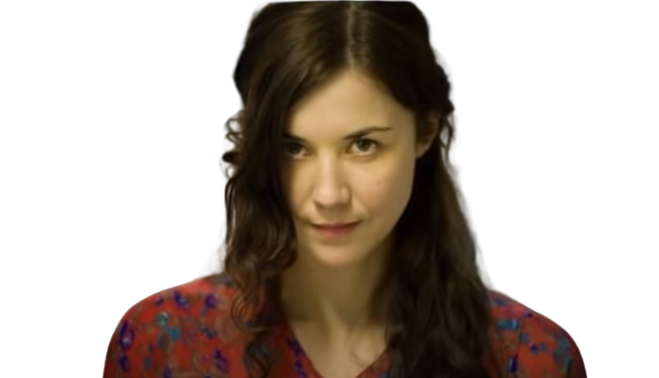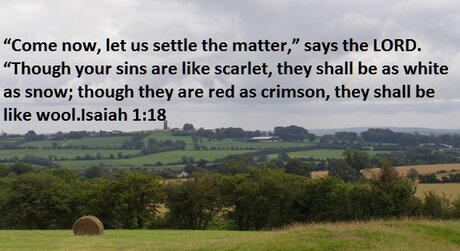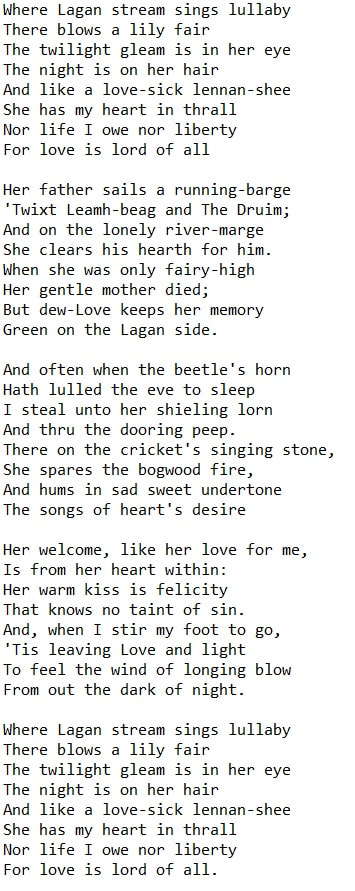My Lagan Love lyrics and guitar chords
The guitar chords in chordpro are in the key of A and another version in G Major.The song was written by Joseph Campbell, recorded by The Coors, Celtic Woman and Senade O'Conner, Lisa Hannigan, Van Morrison, Mary Black, Dusty Springfield, Kate Bush and Charlotte Church and recently by Celtic Thunder. The chords suit the youtube video of Mary Black and Phil Coulter which is in the key of A.
Lyrics And Chords In The Key Of A
[A]Where Lagan stream sings lulla[G]by
There[A] blows a [D]lily fa[A]ir
The twilig[D]ht [A]gleam is in her[G] eye
The[A] nig[D]ht is on her [A]hair
And like a[D] love-[A]sick [C]lennan-[D]shee
She has my[Em] heart[A] in thrall
[Am]Nor life I owe nor li[G]berty
For[A] love is [D]lord of all[A]
Her father sails a running-barge
'Twixt Leamh-beag and The Druim;
And on the lonely river-marge
She clears his hearth for him.
When she was only fairy-high
Her gentle mother died;
But dew-Love keeps her memory
Green on the Lagan side.
And often when the beetle's horn
Hath lulled the eve to sleep
I steal unto her shieling lorn
And thru the dooring peep.
There on the cricket's singing stone,
She spares the bogwood fire,
And hums in sad sweet undertone
The songs of heart's desire
Her welcome, like her love for me,
Is from her heart within:
Her warm kiss is felicity
That knows no taint of sin.
And, when I stir my foot to go,
'Tis leaving Love and light
To feel the wind of longing blow
From out the dark of night.
Where Lagan stream sings lullaby
There blows a lily fair
The twilight gleam is in her eye
The night is on her hair
And like a love-sick lennan-shee
She has my heart in thrall
Nor life I owe nor liberty
For love is lord of all.
Lyrics And Chords K - M
[A]Where Lagan stream sings lulla[G]by
There[A] blows a [D]lily fa[A]ir
The twilig[D]ht [A]gleam is in her[G] eye
The[A] nig[D]ht is on her [A]hair
And like a[D] love-[A]sick [C]lennan-[D]shee
She has my[Em] heart[A] in thrall
[Am]Nor life I owe nor li[G]berty
For[A] love is [D]lord of all[A]
Her father sails a running-barge
'Twixt Leamh-beag and The Druim;
And on the lonely river-marge
She clears his hearth for him.
When she was only fairy-high
Her gentle mother died;
But dew-Love keeps her memory
Green on the Lagan side.
And often when the beetle's horn
Hath lulled the eve to sleep
I steal unto her shieling lorn
And thru the dooring peep.
There on the cricket's singing stone,
She spares the bogwood fire,
And hums in sad sweet undertone
The songs of heart's desire
Her welcome, like her love for me,
Is from her heart within:
Her warm kiss is felicity
That knows no taint of sin.
And, when I stir my foot to go,
'Tis leaving Love and light
To feel the wind of longing blow
From out the dark of night.
Where Lagan stream sings lullaby
There blows a lily fair
The twilight gleam is in her eye
The night is on her hair
And like a love-sick lennan-shee
She has my heart in thrall
Nor life I owe nor liberty
For love is lord of all.
Lyrics And Chords K - M
Here's the Coors version of the chords.
Intro- G C G C G
[G]Where Lagan stream sings [C]lulla[F]by[C]
[G]There[G] blo[C]ws a li[G]ly fair
The twilight gleam is [F]in her eye[C]
The[G] nig[C]ht is [G]on her hair
And like a[C] love-sick [G]lennan-[C]shee
She has my[Dm] heart [G]in thrall
Nor life I owe nor [C]liber[F]ty
For[G] love is lord of all.
Introduction:
Music has always been an integral part of human expression, and it holds a special place in our lives. It has the power to evoke emotions, bring people together, and tell stories. One such song that has stood the test of time and captured the hearts of many is “My Lagan Love.” This traditional Irish folk song has been adapted and performed by numerous artists, making it a timeless classic. In this thesis, we will explore the history, lyrics, and significance of “My Lagan Love” and understand why it continues to enchant listeners even after centuries.
History of the Song:
“My Lagan Love” is a traditional Irish folk song that originated in the early 19th century. The Lagan River, located in Northern Ireland, is the inspiration behind the song's title. The Lagan River has been a vital part of Irish culture and history, and it is often associated with love and romance. The song is said to have been composed by an anonymous poet who lived along the banks of the Lagan River. It was initially an oral tradition, passed down from one generation to another through singing. The song was first published in 1904 in the book “The Songs of Uladh” by Herbert Hughes, which helped in its widespread popularity.
Lyrics and Meaning:
The lyrics of “My Lagan Love” are a combination of Irish and English, which adds to its unique charm. The song tells the story of a young woman who is deeply in love with a man who lives by the Lagan River. She longs for his love and affection, but he is distant and does not reciprocate her feelings. The woman compares her love for him to the beauty and tranquility of the Lagan River, which flows endlessly and remains constant. The lyrics are poetic and evoke a sense of longing, longing for love, and longing for the Lagan River.
Significance of “My Lagan Love”:
“My Lagan Love” is not just a beautiful love song, but it also holds significant cultural and historical importance. In the 19th and 20th centuries, Ireland was going through a period of political and social turmoil. The Irish people found solace in traditional folk songs, and “My Lagan Love” was one such song that provided comfort and a sense of identity. The song became a symbol of Irish pride and patriotism and was often sung during political and social gatherings. It was also used as a form of resistance against British rule in Ireland.
Adaptations and Performances:
Over the years, “My Lagan Love” has been adapted and performed by various artists, both in Ireland and internationally. One of the earliest adaptations of the song was by Herbert Hughes, who added a piano accompaniment to the traditional melody. In the 20th century, renowned Irish tenor John McCormack recorded the song, which further popularized it. Other notable versions include those by Loreena McKennitt, Van Morrison, Mary Black, and Celtic Woman. The song has also been featured in several films and television shows, making it a household name.
Conclusion:
In conclusion, “My Lagan Love” is a timeless Irish folk song that has stood the test of time and continues to enchant listeners with its hauntingly beautiful melody and poetic lyrics. Its significance in Irish culture and history, coupled with its universal theme of love and longing, has made it a beloved song for generations. Whether it is sung in traditional Irish pubs or performed on international stages, “My Lagan Love” will always hold a special place in the hearts of those who hear it.
Music has always been an integral part of human expression, and it holds a special place in our lives. It has the power to evoke emotions, bring people together, and tell stories. One such song that has stood the test of time and captured the hearts of many is “My Lagan Love.” This traditional Irish folk song has been adapted and performed by numerous artists, making it a timeless classic. In this thesis, we will explore the history, lyrics, and significance of “My Lagan Love” and understand why it continues to enchant listeners even after centuries.
History of the Song:
“My Lagan Love” is a traditional Irish folk song that originated in the early 19th century. The Lagan River, located in Northern Ireland, is the inspiration behind the song's title. The Lagan River has been a vital part of Irish culture and history, and it is often associated with love and romance. The song is said to have been composed by an anonymous poet who lived along the banks of the Lagan River. It was initially an oral tradition, passed down from one generation to another through singing. The song was first published in 1904 in the book “The Songs of Uladh” by Herbert Hughes, which helped in its widespread popularity.
Lyrics and Meaning:
The lyrics of “My Lagan Love” are a combination of Irish and English, which adds to its unique charm. The song tells the story of a young woman who is deeply in love with a man who lives by the Lagan River. She longs for his love and affection, but he is distant and does not reciprocate her feelings. The woman compares her love for him to the beauty and tranquility of the Lagan River, which flows endlessly and remains constant. The lyrics are poetic and evoke a sense of longing, longing for love, and longing for the Lagan River.
Significance of “My Lagan Love”:
“My Lagan Love” is not just a beautiful love song, but it also holds significant cultural and historical importance. In the 19th and 20th centuries, Ireland was going through a period of political and social turmoil. The Irish people found solace in traditional folk songs, and “My Lagan Love” was one such song that provided comfort and a sense of identity. The song became a symbol of Irish pride and patriotism and was often sung during political and social gatherings. It was also used as a form of resistance against British rule in Ireland.
Adaptations and Performances:
Over the years, “My Lagan Love” has been adapted and performed by various artists, both in Ireland and internationally. One of the earliest adaptations of the song was by Herbert Hughes, who added a piano accompaniment to the traditional melody. In the 20th century, renowned Irish tenor John McCormack recorded the song, which further popularized it. Other notable versions include those by Loreena McKennitt, Van Morrison, Mary Black, and Celtic Woman. The song has also been featured in several films and television shows, making it a household name.
Conclusion:
In conclusion, “My Lagan Love” is a timeless Irish folk song that has stood the test of time and continues to enchant listeners with its hauntingly beautiful melody and poetic lyrics. Its significance in Irish culture and history, coupled with its universal theme of love and longing, has made it a beloved song for generations. Whether it is sung in traditional Irish pubs or performed on international stages, “My Lagan Love” will always hold a special place in the hearts of those who hear it.



